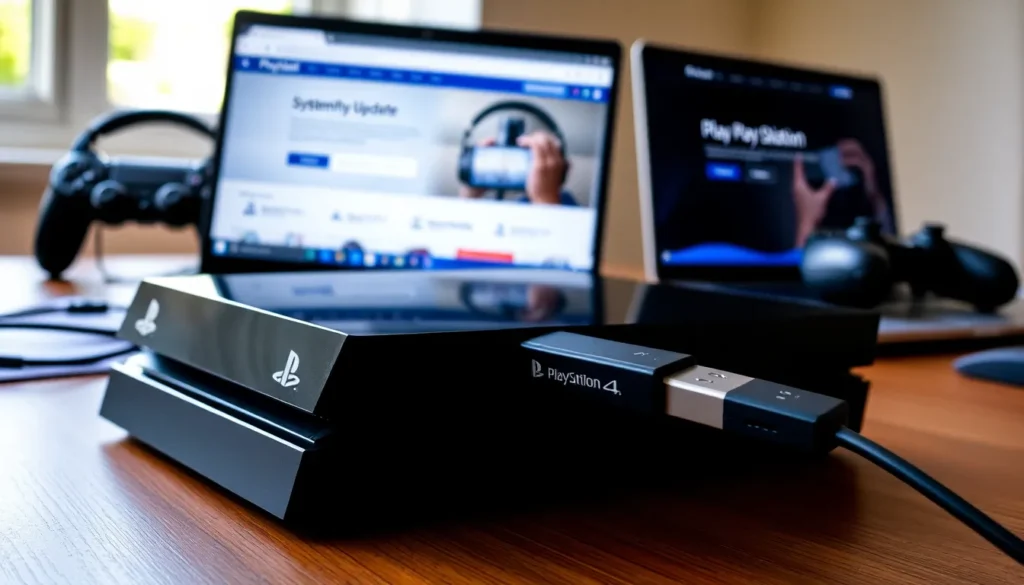Table of Contents
ToggleIn the gaming world, keeping your console updated is crucial for optimal performance, security, and access to the latest features. The PlayStation 4 (PS4) is no exception, and with RamblingsOfAGamer guiding the journey, updating your console via USB can be a straightforward task. This method not only simplifies the process but also provides gamers with a reliable alternative when faced with connectivity issues. In this text, we’ll explore the essential aspects of PS4 system updates, the benefits of USB updates, preparation steps, a detailed guide, and troubleshooting tips to ensure a smooth upgrade experience.
Understanding PS4 System Updates

PS4 system updates are crucial patches that enhance the console’s performance, introduce new features, fix bugs, and improve security. These updates can be downloaded directly from the PlayStation Network (PSN) when the console is online. But, for those who encounter connectivity issues or prefer a more controlled update process, using a USB drive becomes a viable option. Sony regularly releases updates, and staying current is important for a seamless gaming experience, especially for online play. System updates may include graphical enhancements, optimizations, and new game functionality, all of which can significantly improve the user experience.
Benefits of Updating PS4 via USB
Updating a PS4 via USB presents several distinct advantages. Firstly, this method is particularly beneficial for users with slow internet connections or data restrictions. Using a USB can significantly reduce the time taken to download and install updates. Another advantage is that users can manually manage update files, ensuring that they are installing the right update without the hassle of navigating through menus on the PS4 interface. Also, having a backup update stored on a USB stick can be helpful in case of failure during the online update process. Finally, updating via USB can help avoid potential interruptions caused by network issues or PSN outages.
Preparing for a USB Update
Before starting the update process, certain preparations must be made to ensure a smooth update experience. First, users should ensure they have a USB flash drive that is at least 1GB in size and formatted to FAT32 or exFAT. It’s crucial to backup any saved data or game progress to prevent loss during the update. Also, accessing the official PlayStation website to download the latest update file is necessary. Users should create a folder on the USB named “PS4” and another inside it named “UPDATE” to organize the files. This meticulous planning sets the stage for an efficient and straightforward update process.
Step-By-Step Guide to Update PS4 via USB
Updating a PS4 via USB is a straightforward process when broken down into steps:
- Download the System Update File: Head to the official PlayStation website and navigate to the PS4 system software section. Download the latest update file, ensuring it’s named “PS4UPDATE.PUP.”, which is crucial for the recognition process.
- Prepare the USB Drive: Format the USB drive to FAT32 or exFAT if not already done. Create a folder labeled “PS4” on the drive, and then create another folder inside it titled “UPDATE.” Place the downloaded update file in this “UPDATE” folder.
- Plug in the USB Drive: Insert the USB drive into one of the PS4’s USB ports.
- Start the PS4 in Safe Mode: Turn off the PS4 completely, then press and hold the power button. Release it after hearing the second beep, which should occur about seven seconds later. This action will boot the console into Safe Mode.
- Select the Update Option: In Safe Mode, a menu will appear. Select the option that states “Update System Software.” Choose the option to update via USB, and the PS4 will recognize the update file on the USB drive.
- Follow On-Screen Instructions: The system will guide the user through the remaining steps to install the update. This may take several minutes, depending on the size of the update.
- Restart the Console: Upon completion, the PS4 will restart and apply the updates automatically, completing the process.
Troubleshooting Common Update Issues
Even with careful preparation, some users may encounter issues during the update process. Common problems include:
- Error Messages: If the PS4 doesn’t recognize the USB, ensure that the update file is correctly named as “PS4UPDATE.PUP” and that the folder structure is correct.
- Insufficient Storage Space: Make sure there’s adequate free space on the PS4 to accommodate the update.
- Corrupted Update File: If an error occurs during the installation, this may indicate a corrupted download. Re-download the update file from the official PlayStation website and try again.
- Safe Mode Not Activated: Ensure the PS4 is completely powered off before entering Safe Mode. A quick restart rather than a complete shutdown can lead to failure in this step.
Conclusion
Updating a PS4 via USB is a practical alternative to online updates, bringing benefits in terms of speed and reliability, especially for users facing internet connectivity issues. With careful preparation, including understanding system updates and troubleshooting potential problems, gamers can ensure their consoles are always running the latest firmware. Following the steps outlined not only demystifies the process but empowers users to manage their gaming systems more effectively. As technology continues to evolve, being proactive about updates enhances overall gameplay and keeps consoles secure and efficient.




